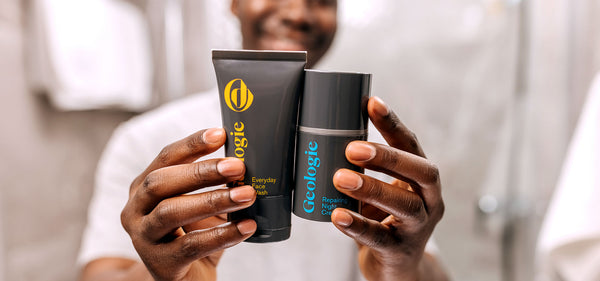When it comes to “super ingredients" — those that can perform multiple functions effectively and consistently — there are only a precious few. Retinol is one that everyone knows about, but azelaic acid is a favorite of our founding dermatologist, Dr. Steve. A key ingredient in the fight against acne, azelaic acid can actually play many positions very well. We asked him to explain.
In this article, you’ll learn:
- What is azelaic acid?
- What does azelaic acid do?
- The benefits of azelaic acid.
- The side effects of azelaic acid.
What is azelaic acid?
Azelaic acid is a naturally occurring compound found in grains like barley, wheat and rye. As an ingredient for skincare, it was synthesized for mild to moderate rosacea and approved in 2002. “People like it because it’s associated with natural ingredients,” said Geologie founding dermatologist Dr. Steve.

What does azelaic acid do?
Azelaic acid is a super ingredient because it's effective in four key ways:
It’s a skin lightener. Azelaic acid is a tyrosinase inhibitor, meaning it can prevent hyperpigmentation because it interferes with melanin production. “Azelaic acid can give you a little bit of brightness in darker spots,” said Dr. Steve, “especially if you’ve got post inflammatory hyperpigmentation (PIH) due to acne.”
It’s anti-inflammatory. “Azelaic acid has anti-inflammatory properties — in the same niacinamide category, but probably a little bit more potent,” said Dr. Steve. “That's why it’s really good for fighting acne: it fights the inflammatory aspect but also fights the dark spots that can occur after. It's also what we use for redness with things like rosacea. We dermatologists also think azelaic acid works as an antioxidant, not perfectly modeled yet and studies, but we think it has those properties.”
It’s an exfoliant: “Azelaic acid does have an exfoliant characteristic just like a beta hydroxy acid like salicylic acid or an alpha hydroxy acid,” said Dr. Steve. “It’ll help flush scaly skin to get it smoother.”
It's well tolerated. Azelaic acid doesn't cause dryness and irritation like retinoids do. “It can cause a little redness, like any acid can cause some issues, but that’s all. It's also one of the few ingredients that is actually safe in pregnancy, and one of the few products we offer pregnant women.

What are Azelaic acid’s side effects?
If you’ve got sensitive-skin, the anti-inflammatory properties of the azelaic acid can lead to stinging, burning and hyperpigmentation. “It’s not typical, but it can happen,” said Dr. Steve, who noted that hyperpigmentation can occur when applying azelaic acid to thinner skin areas near the lips or eyes. “Dermatologists used to prescribe the 20% version, but now, with the Clear System over-the-counter at 5% azelaic acid, you’ll see very little side effects.”
Still, if you are super sensitive and everything stings, burns and irritates your skin, do a patch test on the back of your arm before committing to azelaic acid. If there's no reaction, apply it to your neck and your face last.
How Geologie can help fight acne
Go personalized! Take our skincare quiz for an anti aging skincare routine personalized just for you.
Want something quick and easy? Try our Clear System. This is our simple 3-step skincare solution made up of our salicylic acid face wash and retinol night cream - perfect for fighting breakouts.
Not ready for a routine? A good place to start is with our best selling Salicylic Acid Exfoliating Cleanser 2-Pack. The primary active ingredient is 2% salicylic acid – is an ace exfoliator that combats acne and oil, reduces inflammation, and promotes healing.
Still not sure? Browse our entire catalog of acne skincare products.




























